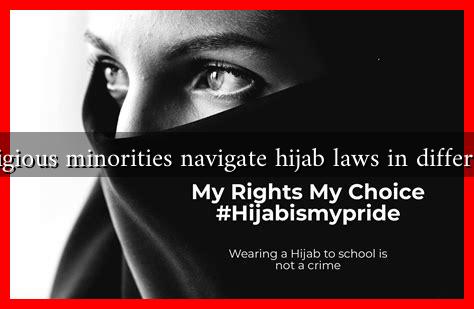-
Table of Contents
- How Do Religious Minorities Navigate Hijab Laws in Different Nations?
- The Global Landscape of Hijab Laws
- Case Studies: Navigating Hijab Laws
- France: A Complex Relationship with Secularism
- Turkey: A Shift in Policy
- United States: A Model of Religious Freedom
- Statistics and Public Opinion
- Conclusion: The Ongoing Struggle for Religious Expression
How Do Religious Minorities Navigate Hijab Laws in Different Nations?
The hijab, a traditional headscarf worn by many Muslim women, has become a focal point of debate in various countries around the world. The laws governing its use vary significantly, reflecting broader societal attitudes towards religious expression, gender rights, and cultural identity. This article explores how religious minorities navigate hijab laws in different nations, highlighting the challenges they face and the strategies they employ to assert their rights.
The Global Landscape of Hijab Laws
Hijab laws are not uniform across the globe; they range from outright bans to complete freedom of choice. Understanding this landscape is crucial for appreciating the experiences of religious minorities. Here are some key categories of hijab laws:
- Prohibitive Laws: Countries like France and Belgium have implemented laws that ban the wearing of hijabs in public spaces, particularly in schools and government buildings.
- Permissive Laws: Nations such as Turkey and Indonesia allow the hijab but have faced internal debates about its place in public life.
- Neutral Stance: Countries like the United States and Canada generally uphold freedom of religious expression, allowing individuals to wear the hijab without legal restrictions.
Case Studies: Navigating Hijab Laws
To better understand how religious minorities navigate these laws, we can examine specific case studies from different countries.
France: A Complex Relationship with Secularism
In France, the 2004 law prohibiting the wearing of conspicuous religious symbols in public schools has had a profound impact on Muslim women. The law is rooted in the country’s commitment to secularism, but it has been criticized for disproportionately affecting Muslim students. Many women have responded by:
- Seeking alternative educational institutions that are more accommodating.
- Engaging in activism to challenge the law, such as participating in protests and legal battles.
- Utilizing social media platforms to raise awareness and garner support.
Despite these challenges, many women continue to wear the hijab as a form of resistance and personal expression.
Turkey: A Shift in Policy
Turkey presents a contrasting case where the hijab was historically banned in public institutions. However, recent years have seen a shift in policy, allowing women to wear the hijab in schools and government offices. This change has empowered many women, leading to:
- Increased participation in public life and politics.
- A resurgence of Islamic identity among younger generations.
- Ongoing debates within the country about secularism and religious expression.
While the policy shift has been welcomed by many, it has also sparked tensions between secular and religious factions within Turkish society.
United States: A Model of Religious Freedom
In the United States, the First Amendment protects the right to wear religious attire, including the hijab. However, Muslim women still face challenges, such as discrimination and harassment. Strategies for navigating these challenges include:
- Building community support networks to foster solidarity.
- Engaging in legal advocacy to challenge discriminatory practices.
- Promoting awareness and education about Islam and the hijab in broader society.
Organizations like the Council on American-Islamic Relations (CAIR) work tirelessly to support Muslim women facing discrimination, providing resources and legal assistance.
Statistics and Public Opinion
Public opinion on hijab laws varies widely. A 2021 survey by the Pew Research Center found that:
- In France, 62% of respondents supported the ban on hijabs in public schools.
- In Turkey, 70% of respondents favored the right to wear the hijab in public institutions.
- In the U.S., 85% of respondents believed that individuals should be free to wear religious attire without restrictions.
These statistics highlight the diverse attitudes towards hijab laws and the complexities faced by religious minorities in different contexts.
Conclusion: The Ongoing Struggle for Religious Expression
The navigation of hijab laws by religious minorities is a multifaceted issue that reflects broader societal values and tensions. While some countries impose restrictive laws that challenge personal freedoms, others embrace religious expression as a fundamental right. The experiences of Muslim women across the globe illustrate the resilience and agency of individuals in the face of adversity. As discussions around religious freedom continue to evolve, it is essential to recognize the diverse perspectives and experiences that shape this ongoing struggle.
For further reading on this topic, you can explore resources from organizations like CAIR and the Pew Research Center.


